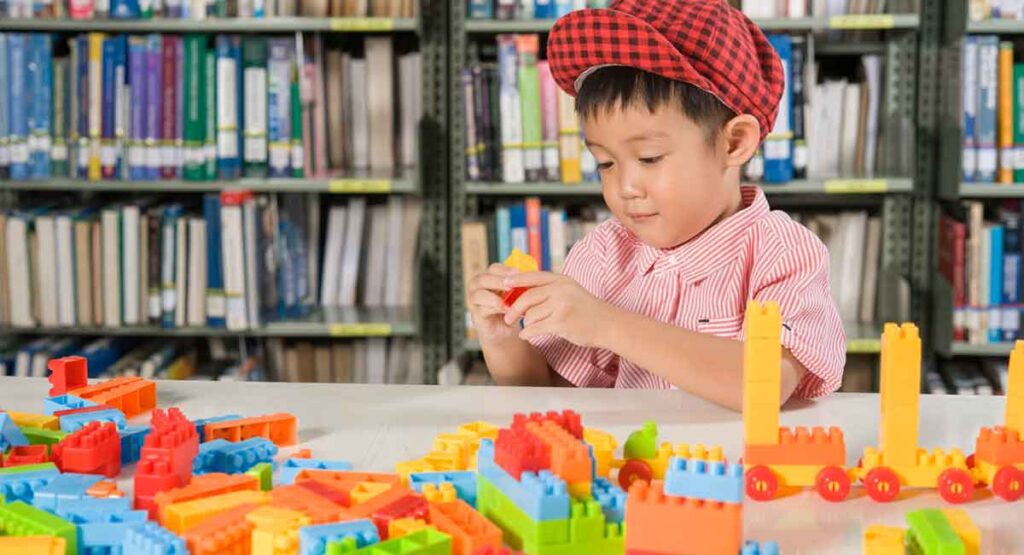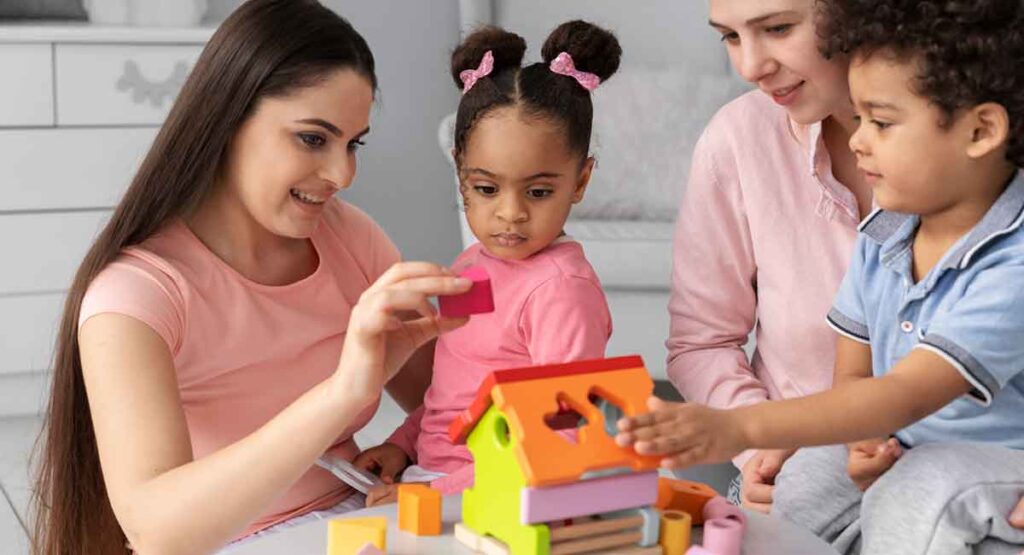Co-Lead Teaching: Benefits, Challenges, and Rewards

Today, we’d like to share the experience of Celia Arseneault, a dedicated educator who completed our MCTD program and now teaches at The Montessori Children’s Academy in Short Hills. Her unique journey offers valuable insights into different teaching options available after completing a Montessori Teacher Education Program. Embarking on the Montessori Journey Celia’s path to becoming a Montessori teacher began with her own children. Witnessing firsthand how each child learns differently and the empowerment that freedom of movement within a prepared environment provides, Celia was inspired by Maria Montessori’s philosophy: “Help me do it by myself.” This journey not only expanded her professional horizons but also led to significant self-discovery. MCTD’s caring and devoted staff played a crucial role in her success, providing unwavering support and motivation. From Assistant to Co-Lead Teacher Starting as an intern and later as a part-time Assistant Teacher, Celia learned the essentials of creating a prepared Montessori environment, handling Montessori manipulatives, and the importance of observation. Despite being well-prepared and certified, she realized that transitioning to the role of Head Teacher was a significant responsibility, impacting the formative years and sensitive periods of a child’s development. When an opportunity arose to co-lead an afternoon class at The Montessori Children’s Academy of Short Hills, Celia saw it as the perfect bridge from Assistant to Head Teacher. Co-leading offered a balanced approach to stepping into a more senior role without the immediate full responsibility of a Head Teacher. Benefits of Co-Lead Teaching Co-lead teaching involves sharing classroom responsibilities and accountability with another directress. This setup has several benefits: Shared Responsibilities: Tasks such as Parent-Teacher Meetings, monthly newsletters, classroom management, and seasonal projects become more manageable and successful when shared. Collaborative Efforts: The exchange of ideas and collaboration enhances the teaching experience and outcomes for students. Backup Support: Having a co-teacher means there is always someone to cover in case of family emergencies or short-term personal illness. Reassurance: The constant knowledge that you are not alone in handling classroom challenges is comforting and encouraging. Challenges of Co-Lead Teaching However, co-lead teaching also comes with its own set of challenges: Respect for Different Teaching Styles: Both teachers must respect each other’s teaching styles and acknowledge that these differences can provide balance for their students. Communication: There can be a breakdown in communication if not all matters are discussed with both teachers. It’s essential to share important information promptly. Unified Lesson Presentation: Teachers may have different ideas on how to present a lesson. Touring the classroom together and discussing lesson presentations can help resolve this. Equal Workload: The workload must be evenly distributed to prevent resentment and concerns over economic inequality. The Importance of Open Communication The key to overcoming these challenges is open communication from the start. Honest and respectful dialogue throughout the year is crucial for a successful co-lead teaching experience. This communication ensures that both teachers are on the same page and can present a united front to their students. Mentorship and Mutual Growth In some co-lead scenarios, one directress may be more experienced than the other. This dynamic can foster a mentorship relationship, with the senior teacher passing down valuable experience and knowledge. Alternatively, co-lead teaching can be a mutual exchange of ideas between teachers of similar experience levels. In both cases, the teachers benefit from working together, enhancing their skills and understanding of children’s development. Conclusion Co-lead teaching provides an excellent opportunity for new teachers to gain experience and prepare for future roles. A successful co-lead year can bridge gaps in experience and confidence, offering a supportive environment to grow professionally. When nurtured with respect, grace, and courtesy—the Montessori way—co-lead teaching can be incredibly rewarding for both educators and students. Celia’s journey through the MCTD program and her experience as a co-lead teacher at The Montessori Children’s Academy highlight the benefits and challenges of this teaching model. For educators considering a Montessori Teacher Education Program, co-lead teaching offers a fulfilling and enriching path to developing their careers and making a lasting impact on their students.
Opportunities for Movement in the Montessori Classroom: Kinesthetic Learning

In Montessori education, the concept of kinesthetic learning—learning through movement—is fundamental. This approach is rooted in the belief that “what the hand does, the brain remembers,” as stated by Dr. Maria Montessori. Through my own experiences in Montessori classrooms, I’ve observed that children, particularly boys, require movement that goes beyond just using their hands. They need opportunities for whole-body movement and the freedom to move throughout the day. The Importance of Kinesthetic Learning Kinesthetic learning in the Montessori classroom involves engaging students in activities that require physical movement. This method not only helps in refocusing energy but also enhances learning and retention. Many Montessori materials are designed to incorporate kinesthetic movement, aligning with Dr. Montessori’s philosophy. Whole-Body, Heavy Works Some Montessori activities involve whole-body movement and are physically demanding. Examples include: Gardening: Digging, planting, and watering plants. Shoveling Snow and Raking Leaves: Seasonal activities that promote physical exertion and cooperation. Vacuuming and Washing Windows: Practical life skills that involve repetitive, meaningful movement. Pounding Nails into a Stump: An engaging activity that develops hand-eye coordination and strength. These activities provide an excellent way for children to channel their energy constructively. Creating a Flexible and Active Environment The Montessori classroom is designed to offer numerous opportunities for movement and flexibility. Here are some ways to incorporate non-distracting movement: Flexible Workspaces Floor Work: Children can work on the floor, allowing them to spread out and move more freely. Varied Seating Options: Pillows, rocking chairs, and other comfortable seating arrangements accommodate different needs and preferences. Freedom to Move Unrestricted Movement: Children can move around the classroom at will, gather materials, have a snack, or take a break with friends. Fidget Tools and Pocket Toys: Allowing children to use these tools can help them refocus. For instance, modeling clay or a “Koosh” ball can be used discreetly to manage restless energy. Breaks and Outdoor Time Permission to Take Breaks: Children are allowed to take breaks as needed, staying within sight of the classroom. This helps them work off physical energy and return to tasks with renewed focus. Indoor Alternatives for Inclement Weather: Keeping a tub of Lego building blocks or similar activities available provides an outlet for movement when outdoor play is not possible. The Detriment of Restricting Movement One of the worst things you can do to any student is to punish them by restricting movement. Have you ever taken away recess or gym class because a child couldn’t settle down? This approach is counterproductive, as the children who struggle to stay still are often those who need movement the most. Restricting their physical activity can lead to increased behavior problems and diminished concentration. Conclusion Movement is a crucial aspect of learning in the Montessori classroom. By providing opportunities for kinesthetic learning, educators can help children channel their energy positively, enhance their engagement, and improve their overall learning experience. Ensuring that children have the freedom to move, use fidget tools, take breaks, and engage in whole-body activities supports their development and well-being. Incorporating movement into the daily routine of a Montessori classroom is not just beneficial but essential. It fosters a dynamic and engaging learning environment where children can thrive. By embracing the principles of kinesthetic learning, we can help students develop a love for learning that is both active and enduring.
My Personal Experience with the Montessori Center for Teacher Development (MCTD)

My Montessori journey began three years ago when I decided to return to work after being a stay-at-home mom for twelve years. Before having children, I spent over a decade as a Museum Educator, where I developed a deep appreciation for hands-on learning and providing students with opportunities to explore subjects they are passionate about. A friend suggested I consider teaching at a Montessori school, believing that my educational philosophy aligned with Montessori principles. After some research, I discovered the Montessori Center for Teacher Development (MCTD) program and decided to apply. The Start of My Montessori Journey The first step in the application process was observing a local Montessori school. This initial observation was eye-opening. As soon as I entered, I saw students quietly concentrating on various lessons with gentle and encouraging guidance from their teacher. I was immediately captivated. Although I knew nothing about the Montessori Method at the time, the engagement and happiness of the students convinced me that this was a teaching method worth exploring further. Enrolling in the MCTD Program I was thrilled to learn that the MCTD program offered certification to teach children aged 2 ½ to 6 years old. I have always been drawn to the natural curiosity and enthusiasm young children display when given the right learning environment. However, I had many questions and concerns about returning to school. Balancing academic responsibilities with my duties at home seemed daunting. Would I remember how to write a research paper? Could I confidently present lessons in class? With the support of my family, my cohort of Adult Learners, and the wonderful MCTD staff, I successfully navigated this new chapter in my life. I began the program in the summer of 2017, intending to stay home with my children while completing the Academic Phases, then start working in the fall of 2018 when my Practicum began. Hands-On Learning and Professional Growth Plans changed when an opportunity arose, and I was hired as an Assistant Teacher at a local Montessori school in September. Working while taking courses was incredibly beneficial. I could immediately apply what I learned in the MCTD program to real-life classroom settings. My role as an ‘on-staff substitute assistant’ allowed me to observe various classrooms and teaching styles, reinforcing my belief in the effectiveness of hands-on learning. The Montessori courses during the Academic Phases started with a thorough introduction to Maria Montessori and her innovative didactic materials. Understanding her background and philosophy was crucial to appreciating the Montessori classroom. Reflecting on my early days in the classroom, I realize how much I have learned about Maria Montessori’s approach and its profound impact on children’s education. Practicum Phase: Deepening My Understanding During the Practicum Phase, my Supervising Teacher provided endless opportunities to present lessons and develop new ones using Montessori materials. I rediscovered my passion for teaching and eagerly anticipated observing students’ “ah-ha” moments when they independently grasped a lesson they had worked hard on. The MCTD program offers comprehensive guidance and support, ensuring Adult Learners like myself, who had no prior Montessori experience, can succeed. Beyond professional growth, I have experienced personal growth as well. Juggling numerous responsibilities has forced me to become more organized, procrastinate less, and build confidence both in and out of the classroom. I had forgotten how enjoyable learning could be, and as a Montessori Teacher, the learning never stops for both teachers and students. Looking Forward Admittedly, there have been many late nights writing papers and last-minute trips to find materials for lessons. However, looking back, it was all worthwhile. I now know that I have found my calling for the next phase of my career and am excited about what the future holds. The MCTD program has been instrumental in my journey, and I am grateful for the skills and experiences it has provided. As I continue to grow and learn alongside my students, I am confident that I am prepared to contribute positively to the lives of the young children I teach. If you are considering a career in Montessori education, I highly recommend the MCTD program—it has been a transformative experience for me, both professionally and personally. Embrace the journey, and you too may find your passion for teaching reignited, just as I have.
The Importance of Pre-Primary Teacher Training Courses in Early Childhood Education

The childhood phase is the cornerstone of human development, laying the foundation for mature, responsible adults. Proper preliminary education in schools plays a crucial role in channeling the self-motivated activities of children, preparing them to be responsible future citizens. The early educational experiences that children receive profoundly influence their physical and mental development. Research shows that children undergo significant physical, cognitive, and emotional development before the age of five. This underscores the need for exceptional teachers who can play a pivotal role in nurturing and bringing out the best in these young minds. A pre-primary teacher training course is instrumental in preparing educators to meet this vital need, equipping them with the skills to handle children effectively and foster an engaging classroom environment. The Role of Pre-Primary Teacher Training in Early Childhood Education Holistic Teacher Preparation Comprehensive Curriculum: Pre-primary teacher training courses offer a holistic approach to preparing educators. These courses cover various teaching methodologies, classroom management techniques, and child psychology. Focus on Early Development: Training emphasizes the critical aspects of early childhood development, ensuring that teachers can support and enhance physical, cognitive, and emotional growth in young children. Enhancing Teaching Methodologies Innovative Teaching Techniques: The courses introduce innovative teaching techniques tailored to young learners. These methods prioritize learning through play, which is crucial for engaging children and promoting their natural curiosity. Practical Training: Teachers receive hands-on experience and feedback from experienced faculties, helping them refine their teaching practices and better connect with their students. Guidance for Maximizing Student Potential Mentorship Skills: Pre-primary teacher training courses equip teachers with the skills to act as mentors, guiding children towards reaching their maximum potential. This includes fostering a love for learning and encouraging socialization and cooperation among peers. Personalized Attention: Teachers learn to provide personalized attention, catering to the unique needs and learning styles of each child, thus promoting a more effective and inclusive learning environment. The Importance of Trained Preschool Teachers Parents dream of seeing their children stand out as unique individuals in society. To achieve this, they often enroll their children in preschools. However, the crucial factor of having dedicated and trained preschool teachers is sometimes overlooked. This is where the importance of pre-primary teacher training courses becomes evident. Professional Skills Development: These courses ensure that preschool teachers are professionally skilled and capable of delivering high-quality education. Trained teachers are better equipped to create a stimulating learning environment that maximizes the benefits of early childhood education. Confidence and Competence: With proper training, teachers become more confident and competent in handling the diverse challenges of early childhood education, from managing classroom behavior to implementing effective teaching strategies. Conclusion Investing in pre-primary teacher training courses is essential for the advancement of early childhood education. These courses prepare educators to meet the developmental needs of young children, ensuring that they receive a strong foundation for future learning and growth. By focusing on comprehensive training, innovative teaching methodologies, and the development of mentorship skills, pre-primary teacher training courses contribute significantly to the overall development of children. Dedicated and trained preschool teachers are vital for maximizing the outcomes of preliminary education. As such, it is imperative for educational institutions and parents alike to recognize the value of these training programs. Enrolling in a pre-primary teacher training course is a step towards creating a brighter, more knowledgeable future for our children, one that nurtures their potential and prepares them for the challenges ahead. Embrace the opportunity to make a difference in the lives of young learners. Enroll in a pre-primary teacher training course today and become a pivotal part of shaping the future generation.
How is Pre-Primary Teacher Training Course Related to Child Education System?

The child education system, a specialized branch of teaching focused on infants and young children, is foundational to their overall development. Early childhood education emphasizes playful learning to address emotional and mental growth, setting the stage for future academic success. Pre-primary teacher training courses are pivotal in preparing educators to navigate and contribute effectively to this system. Here’s how these courses interconnect with and enhance the child education system. Understanding the Child Education System The child education system is designed to cater to the developmental needs of infants and young children. Unlike traditional education, it focuses on holistic growth rather than mere academic achievement. This system prioritizes: Emotional Development: Helping children understand and manage their emotions. Mental Development: Enhancing cognitive abilities through playful learning. Social Skills: Encouraging interaction and cooperation among peers. To facilitate these goals, educators must be adept at creating a nurturing and stimulating environment. This is where pre-primary teacher training courses come into play. Training Offered by Pre-Primary Teacher Training Courses Pre-primary teacher training courses equip educators with the necessary skills and knowledge to support and enhance the child education system. Here are the key areas of training: Behavioral and Psychological Understanding Training Focus: Teachers learn to understand the behavioral and psychological aspects of children. Benefit: This knowledge allows teachers to address individual needs effectively, fostering a supportive learning environment. Socialization and Cooperation Skills Training Focus: Teachers acquire skills to help children socialize and build cooperative relationships with their peers. Benefit: Promotes a harmonious classroom atmosphere where children learn to work and play together. Latest Teaching Methods and Classroom Practices Training Focus: Courses cover the latest teaching methodologies and practical classroom techniques. Benefit: Ensures that educators are up-to-date with modern educational practices, enhancing their teaching effectiveness. Mentorship and Guidance Skills Training Focus: Teachers gain the ability to act as mentors, guiding children in their overall development. Benefit: Encourages a holistic approach to education, addressing both academic and personal growth. Creating an Interactive Classroom Atmosphere Training Focus: Teachers learn to create engaging and interactive classroom environments. Benefit: Keeps children involved and motivated through playful and participatory learning methods. The Importance of Updated Training Curriculum A lack of proper training can significantly hinder student learning. Therefore, it is crucial for teacher training courses to incorporate the latest educational curriculum and teaching strategies. By doing so, these courses ensure that teachers are not only capable of instructing but also of encouraging, guiding, and inspiring children to develop a love for learning. Conclusion Pre-primary teacher training courses are intrinsically linked to the child education system, providing the necessary tools and knowledge for educators to thrive. By focusing on comprehensive training that includes understanding behavioral and psychological aspects, promoting social skills, adopting modern teaching methods, and creating interactive classrooms, these courses prepare teachers to make a meaningful impact on young children’s lives. Investing in such training is essential for anyone looking to contribute positively to early childhood education and shape the future generation. Embrace the opportunity to become a well-equipped pre-primary educator and join a training course today. Your dedication to early childhood education will pave the way for a brighter, more knowledgeable future for our youngest learners.
5 Essential Things That You Want to Know about Pre-Primary Teacher Training Course

The childhood phase is the basic foundation stone of our lives. The strong the foundation, the better a child would be in the later stage of life. And to restructure the self-motivated activities of the kids and make them responsible future citizens, it is crucial to have a proper pre-primary education system in the schools. This early educational journey that a kid gets affects their overall development both physically and mentally. Children exhibit a notable physical, cognitive and physical development before the age of five. So, it is crucial to have good teachers who will play an important role in their lives. Do you want to be that special one? Then, a pre-primary teacher training course can help you a lot.It is a holistic course for both aspiring pre-primary and primary school teachers. It trains the teachers on teaching methodologies so that they can guide students to reach their maximum potential. How is a pre-primary teacher training course connected to the child education system?Child education system is a vital part of the whole education system that focuses on the key areas of their development. Early childhood education does not focus on text-based studies. Rather, it stresses on providing teaching through playing that helps kids meet the emotional and mental aspects. During the pre-primary teacher training course, the aspiring teachers are taught how to help kids explore the world of knowledge playfully that will contribute to their development. The course enables teachers to delve deep into the child education system that ultimately helps them to be a successful teacher. What are the ways an online pre-primary teacher training course helps you?Developed by experienced academicians, an online teacher training course consists of diverse modules. And each of them focuses on an important aspect of the child education system. You will get training on the understanding of behavioural and psychological aspects of children. Training on the latest teaching methods, as well as classroom teaching practice combined with feedback from experienced faculties. Skills of knowledge and guidance to act as mentors to children for overall development.Training on the ability to create an interactive classroom atmosphere to get students’ involvement playfully.Lack of providing the right knowledge to students can affect student learning. A pre-primary teacher training course incorporates the latest teaching methodologies and theories that not only help you to teach effectively but also guide you to encourage, guide and inspire a child to love learning. How does an online course work?After enrolling in the course, students are given access to the online course. You will be given a unique username and password and the link to the online course. You can log in at any time of the day to go through the course material and answer it. What is the evaluation process?The evolution process of the pre-primary teacher training course is scientific and easy. There are sets of multiple-choice questions at the end of each module. You need to complete the MCQs to complete the certificate course. In the Diploma level, aspiring teachers need to submit an assignment and research paper if required.Is the training program recognised by the government?The pre-primary teacher training program is an internationally recognised course. After the successful completion of the course, the candidates will get a globally accredited certificate that will help you get jobs in all across the world. If you enroll in a reputable teacher training institute like APTTI and complete the course successfully, you will get job assistance from them. And as the course fee is affordable, it will never be a burden for you. So, what to wait for? Enroll yourself in an online pre-primary course and prepare to be a better teacher tomorrow.
